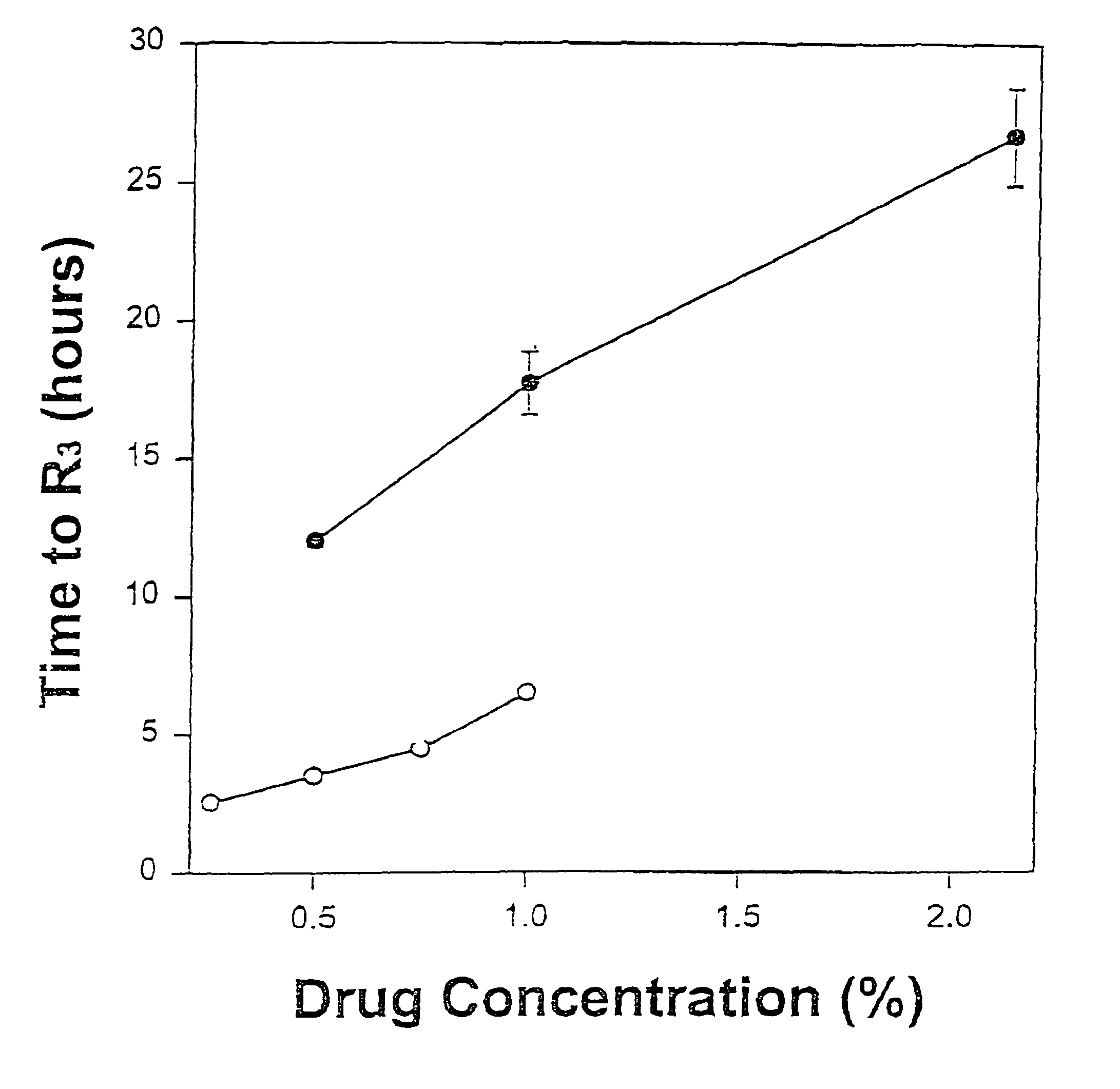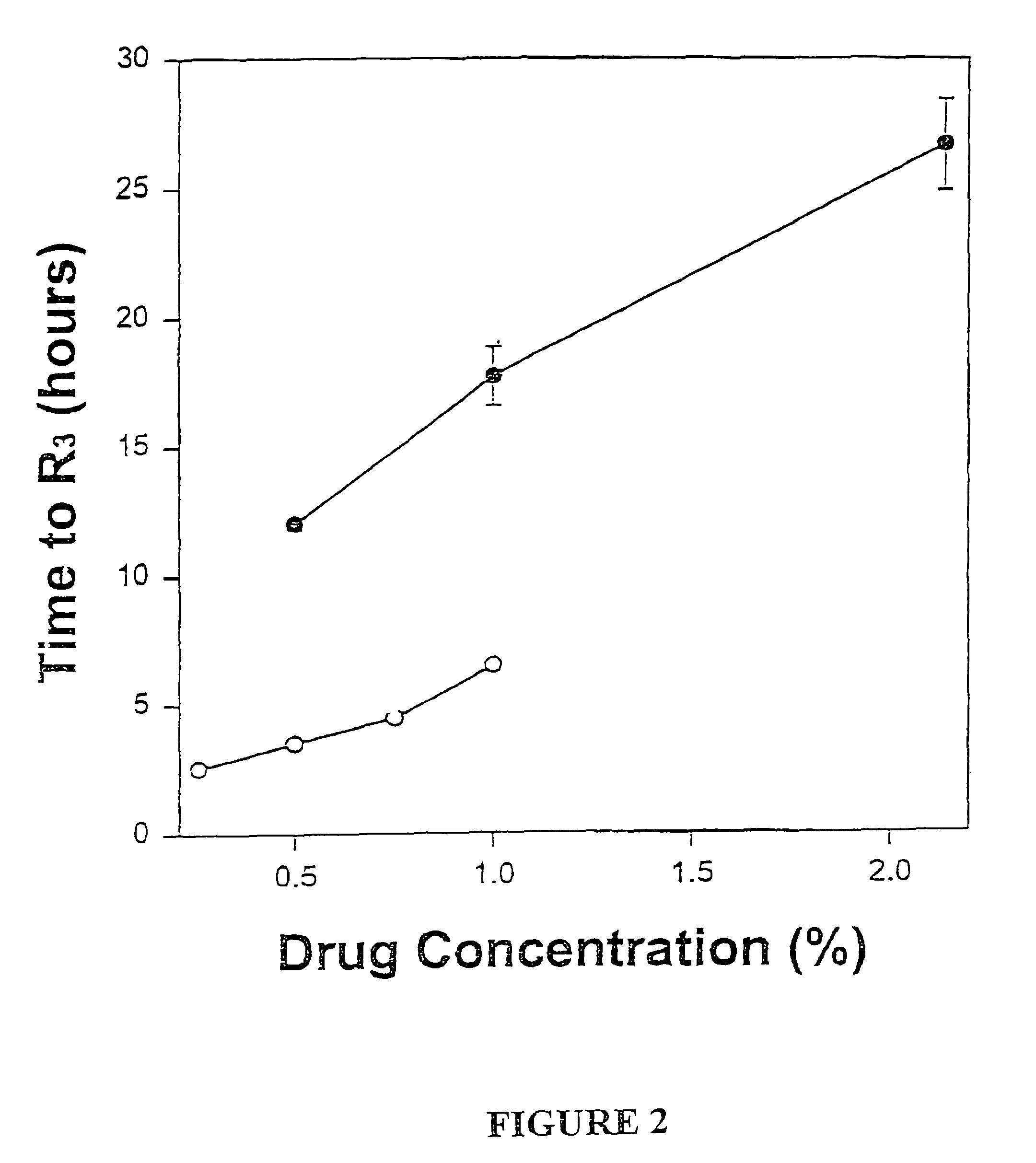Sustained-release liposomal anesthetic compositions
a liposomal anesthetic and composition technology, applied in the field of liposomal formulations, can solve the problems of inacceptable formulations for encapsulating biologically active substances in mvl or very low encapsulation efficiency, and achieve the effects of sustained release, low encapsulation efficiency, and improved encapsulation efficiency
- Summary
- Abstract
- Description
- Claims
- Application Information
AI Technical Summary
Benefits of technology
Problems solved by technology
Method used
Image
Examples
example 1
Manufacture of Bupivacaine-phosphate-containing MVL
[0042]Bupivacaine hydrochloride (Sigma Chemical Co., St. Louis, Mo.) was converted into bupivacaine phosphate by initial precipitation of aqueous bupivacaine hydrochloride with 1N sodium hydroxide to prepare the free base. The precipitate was extensively washed with water, and then converted into phosphate salt with an equimolar amount of phosphoric acid. For each batch of the formulation, 5 mL of a discontinuous first aqueous component containing 60 mg / mL of bupivacaine phosphate, 150 mM glucuronic acid, 15 mN hydrochloric acid, and 20 mM phosphoric acid was added to a mixer vessel containing a lipid component containing 5 mL of USP chloroform (Spectrum Chemical Co., Gardena, Calif.) as solvent, and 18.6 mM 1,2-dierucoyl-sn-glycero-3-phosphocholine (DEPC), 4.2 mM dipalmitoyl phosphatidylglycerol (Avanti Polar-Lipids, Inc., Alabaster, Ala.) (an anionic amphipathic lipid), 30 mM cholesterol (Avanti Lipids), and 10.8 mM tricaprylin. T...
example 2
Recovery of Bupivicaine from Different MVL Formulations
[0044]The bupivicaine samples were solublized by adding an equimolar volume of a 1M solution of the indicated acid and then slowly adding, with stirring, additional water until 60 mg / mL or a clear solution was achieved. The pH was then adjusted to approximately 5. The final bupivicaine concentration was determined by HPLC against an internal standard.
[0045]For each formulation attempt, the first aqueous phase solution contained the bupivicaine counterion at 60 mg bupivicaine per mL, or the limit of solubility of the bupivicaine counterion, at pH 5. Other parameters for MVL manufacture was as described above. Recovery refers to percent of bupivicaine in counterion solution encapsulated and recovered in final MVL product. For study 2, the first aqueous phase also contained 150 mM glucuronic acid. The results are shown in Table 1.
[0046]
TABLE 1Recovery of MVL-encapsulated bupivicaine fromFormulations Containing Various AcidsBupivica...
example 3
In vivo Animal Studies using Intracutaneous Injections
[0048]Male guinea pigs weighing 800-1000 grams (Harlan Sprague-Dawley, San Diego, Calif.) were used for efficacy studies. Male guinea pigs (Harlan-Sprague-Dawley) weighing 400-600 grams were used for pharmacokinetic studies. The animals were housed, 1 per cage, in a temperature-controlled environment with alternating 12-hour periods of light and darkness and given unrestricted access to food and water. Prior to each study, animals were habituated to the environment for at least 7 days. Female CD 1 mice (Sprague-Dawley) weighing 22-28 grams were used for determination of maximum tolerated dose (MTD) All animals were maintained in accordance with guidelines of the Committee on Care and Use of Laboratory Animals of the Institute of Laboratory Animal Resources, National Research Council.
[0049]The formulations of MVL-encapsulated bupivacaine and bupivacaine hydrochloride prepared as described above were diluted in normal saline so tha...
PUM
| Property | Measurement | Unit |
|---|---|---|
| pH | aaaaa | aaaaa |
| volume | aaaaa | aaaaa |
| volume | aaaaa | aaaaa |
Abstract
Description
Claims
Application Information
 Login to View More
Login to View More - R&D
- Intellectual Property
- Life Sciences
- Materials
- Tech Scout
- Unparalleled Data Quality
- Higher Quality Content
- 60% Fewer Hallucinations
Browse by: Latest US Patents, China's latest patents, Technical Efficacy Thesaurus, Application Domain, Technology Topic, Popular Technical Reports.
© 2025 PatSnap. All rights reserved.Legal|Privacy policy|Modern Slavery Act Transparency Statement|Sitemap|About US| Contact US: help@patsnap.com



